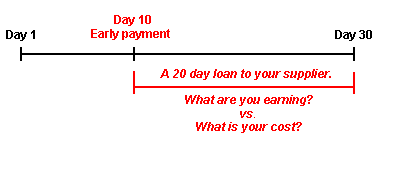
First the general rule on trade discounts: you should always take advantage of trade discounts of 1 percent or more if your suppliers require full payment within 30 days. If your suppliers offer payment terms beyond 30 days, it may be more advantageous to skip the trade discount and delay paying the supplier until the full payment is due.
For situations outside the scope of the general rule, or if you just want to test the general rule, you can determine for yourself if taking a trade discount is advantageous. The following will help you make that determination:
In order to determine if a trade discount is advantageous, you need to consider the annualized interest rate you earn by taking the trade discount. If this annualized interest rate is greater than the interest rate charged to borrow the money from a bank, for example, then the discount is definitely worth taking. On the other hand, if the interest rate charged to borrow the money from a bank is greater than the annualized interest rate earned by taking the discount, then you shouldn't take the trade discount.

When taking a trade discount, you need to consider the early payment a loan to your supplier.
Take, for example, a supplier that offers a discount if their invoice is paid within 10 days, or accepts full payment within 30 days. When you pay this supplier in 10 days, instead of waiting the full 30 days, this supplier is actually borrowing money from you for 20 days. The amount of the discount is the interest you earn on the loan to the supplier. If you view your early payment as a loan to your suppliers, you can then determine the annualized interest rate you're actually earning. Once you know the annualized interest rate, you can then compare it to your cost of borrowing money and determine if taking the discount is worth while.
The annualized interest rate is calculated as follows:
|